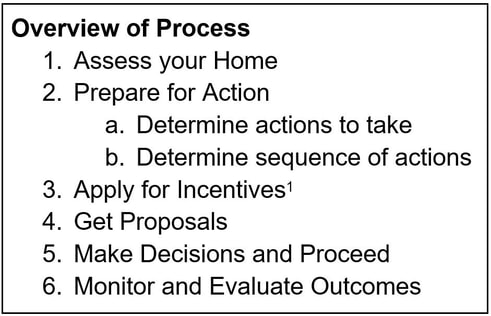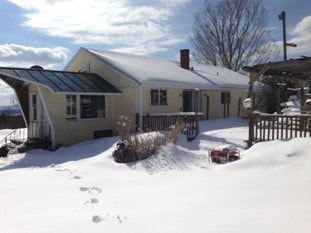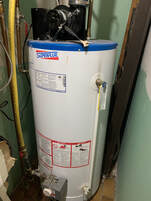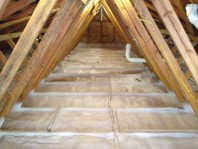Do you want to reduce your home’s carbon footprint, improve comfort, and lower your energy costs? We set out to achieve these objectives and more by creating and implementing a plan of action for our home. We began with energy efficiency measures, then focused on electrification of the home’s fossil-fueled systems and appliances, and the addition of renewable energy. This how-to guide based on what we learned sets forth a pathway to zero carbon that you can apply to your own home.
Here’s an overview of the process we followed.
Here’s an overview of the process we followed.
1. Assess Your Home
The first step to a zero carbon home is to understand your home’s energy use by obtaining an energy assessment from a specialist with the equipment, knowledge, and experience to evaluate your home. An assessment provides an opportunity to speak with a knowledgeable energy professional about your goals for your home and receive a report detailing the assessor’s findings and suggestions. A typical report will tell you about your:
In general, an energy assessment costs 400-500 dollars. Recognizing the value that energy assessments provide, some incentive programs now require one to be done and many reimburse the cost if action is taken to address the assessment’s findings.
The home energy assessor’s report may not include some information that can be useful in guiding your decision making. In addition to the above, you will want to determine:
To determine when to replace your home’s equipment, it is helpful to estimate their expected end-of-life. To do this, look for labels on the equipment that indicate the manufacture date and model number. Then, look up the average life-expectancy of the equipment and compare it with the manufacture date to determine its end-of-life. The model number can also be used to look up the equipment’s efficiency.
- Insulation levels
- Air-tightness
- Total energy use
- Where energy is wasted
- What energy saving opportunities are recommended
In general, an energy assessment costs 400-500 dollars. Recognizing the value that energy assessments provide, some incentive programs now require one to be done and many reimburse the cost if action is taken to address the assessment’s findings.
The home energy assessor’s report may not include some information that can be useful in guiding your decision making. In addition to the above, you will want to determine:
- The end-of-life and efficiency of your home’s equipment (furnace/boiler, air-conditioner, water heater, and appliances)
- Your spare electrical capacity
To determine when to replace your home’s equipment, it is helpful to estimate their expected end-of-life. To do this, look for labels on the equipment that indicate the manufacture date and model number. Then, look up the average life-expectancy of the equipment and compare it with the manufacture date to determine its end-of-life. The model number can also be used to look up the equipment’s efficiency.
|
In the case of our home we found that our gas water heater was 13 years old and 62% efficient. We determined the life expectancy of our type of water heater to be 13 years.2 With this information, we concluded that the water heater was nearing its end-of-life and should be replaced soon. Research into new electric water heaters suggested that electrifying this system would improve efficiency and substantially reduce its carbon footprint.
|
To get a general idea of your spare electrical capacity, look at the number of empty spaces in your electrical panel and its amperage (typically denoted 100, 150, or 200 Amps). Knowing your electrical capacity can help you choose the proper equipment as you pursue electrification.
|
For example, with the right technology you can charge your car on the same circuit as your solar system, thereby saving space on your electrical panel.
|
If your electrical panel is already at capacity, you may need to have it upgraded by a qualified electrician.
2. Prepare for Action
a. Determine actions to take
The pathway to a zero carbon home involves energy efficiency measures, electrification of the home’s fossil-fueled systems and appliances, and the addition of renewable energy. The specific actions and their timing will vary by home. Use your energy assessor’s report, end-of-life dates, efficiency of equipment, and electrical capacity to determine what actions should be taken.
b. Determine a logical sequence of actions
To help determine first steps, identify your home’s best and most cost effective energy efficiency opportunities, the “low-hanging fruit.” Adding insulation is often considered low-hanging fruit because it reduces your utility costs, improves comfort, and can lower the cost of subsequent carbon reduction actions.
a. Determine actions to take
The pathway to a zero carbon home involves energy efficiency measures, electrification of the home’s fossil-fueled systems and appliances, and the addition of renewable energy. The specific actions and their timing will vary by home. Use your energy assessor’s report, end-of-life dates, efficiency of equipment, and electrical capacity to determine what actions should be taken.
b. Determine a logical sequence of actions
To help determine first steps, identify your home’s best and most cost effective energy efficiency opportunities, the “low-hanging fruit.” Adding insulation is often considered low-hanging fruit because it reduces your utility costs, improves comfort, and can lower the cost of subsequent carbon reduction actions.
|
For example, because you now have a well-insulated house, your energy requirements for heating, cooling, and solar have been minimized. So, a new electric heating and cooling system or solar system can be sized more modestly, resulting in lower cost.
|
The “what comes next” options may be impacted by budget, available incentives, end-of-life estimate, and by the previous actions that have been completed. Any equipment that meets the highest number of the following criteria might be considered a higher priority:
- is nearing end-of-life
- incentive is available
- funding is available
- offers substantial efficiency or carbon improvement
|
For example, if my furnace is nearing end-of-life, there is an incentive for replacing it with a heat pump, funding is available, and the energy efficiency and carbon improvements are substantial, I might choose to replace my furnace with a heat pump as my next action.
|
It usually makes the most sense to replace heating, hot water, and air-conditioning equipment toward their end-of-life, but before actual failure. As the equipment approaches end-of-life you are more likely to need to replace parts or do other expensive repairs. Further, waiting until your equipment fails may put you in a situation where you are without heat (risk of broken pipes), cooling, or hot water, which may require making an in-the-moment decision rather than the best decision for the long term. This could result in fewer equipment options and having to pay more.
Tip: Use utility savings from first actions to help fund follow-up actions if your budget is constrained or financing is unavailable.
Tip: Use utility savings from first actions to help fund follow-up actions if your budget is constrained or financing is unavailable.
3. Apply for Incentives
Become informed about the incentive programs available where you live. Incentives may be available from Federal, State/Provincial, and Municipal entities. Many utility providers are now offering incentives as well. Incentives may take the form of rebates, grants, tax credits, or low/no-interest loans.
To find out about available incentive and loan programs, you can:
Tip: In the U.S., visit www.dsireusa.org for a comprehensive list of incentives. In Canada, visit the Canadian Government’s Natural Resources Canada website at www.nrcan.gc.ca.
Once you know the incentives that are available to you, you can apply for them if and when required in relation to getting the work done.
Tip: Keep all quotes, invoices, receipts, and other documents that are required to receive incentives and may be required for future tax filings.
Become informed about the incentive programs available where you live. Incentives may be available from Federal, State/Provincial, and Municipal entities. Many utility providers are now offering incentives as well. Incentives may take the form of rebates, grants, tax credits, or low/no-interest loans.
To find out about available incentive and loan programs, you can:
- Review your energy assessor’s report for incentive information. If your assessor did not include this information in your report, just ask him/her for information about available incentives.
- Call or visit the website of your local utility provider.
- Speak to potential vendors that provide insulation, heat pumps, and solar systems.
- Search the internet
Tip: In the U.S., visit www.dsireusa.org for a comprehensive list of incentives. In Canada, visit the Canadian Government’s Natural Resources Canada website at www.nrcan.gc.ca.
Once you know the incentives that are available to you, you can apply for them if and when required in relation to getting the work done.
Tip: Keep all quotes, invoices, receipts, and other documents that are required to receive incentives and may be required for future tax filings.
4. Get Proposals
Contact multiple vendors and obtain at least two proposals for each individual energy improvement project. Obtaining multiple proposals gives you the opportunity to compare the approaches and pricing of each vendor. Research the equipment your vendors propose to use and compare their efficiency, reliability, cost, and features.
Tip: Reach out to others who’ve gone through the process of reducing their home’s carbon emissions to get contractor suggestions and to help evaluate proposals.
Contact multiple vendors and obtain at least two proposals for each individual energy improvement project. Obtaining multiple proposals gives you the opportunity to compare the approaches and pricing of each vendor. Research the equipment your vendors propose to use and compare their efficiency, reliability, cost, and features.
Tip: Reach out to others who’ve gone through the process of reducing their home’s carbon emissions to get contractor suggestions and to help evaluate proposals.
5. Make Decisions and Proceed
Typical carbon-reducing actions that can be taken include:
Typical carbon-reducing actions that can be taken include:
- Install LED light bulbs
- Insulate and seal
- Add smart thermostat
- Replace fossil-fuel heating, air-conditioning, and water heating equipment with electric
- Replace gas stove and dryer with electric
- Electrify transportation
- Add renewable energy
Things to know for:
- LED Light Bulbs - Start simply by replacing your light bulbs with energy-efficient LED bulbs. LEDs offer the most energy efficient lighting available.
- Insulate and Seal - A well-insulated and sealed home is more comfortable and substantially lowers energy costs.
- Smart Thermostat - You can install a smart thermostat that intelligently manages your heating and cooling system’s energy use. A smart thermostat can be installed either now for efficiency or when replacing your heating or air-conditioning equipment.
- Heating and Air-conditioning system - You can replace your existing air-conditioner and furnace with a cold-weather heat pump. Optionally, you can get a hybrid heat pump system installed with a furnace to enhance resiliency. A smart thermostat can intelligently switch between heat pump and furnace.
- Other Fossil-Fuel Equipment - Replace your gas stove with an electric induction cooktop to realize improved energy efficiency, indoor air quality, and safety. Consider replacing your gas dryer with an electric one.
- Electrify Transportation - You can electrify your transportation and skip visiting the gas station as you charge your vehicle overnight at home.
- Renewable Energy - Add solar panels to bring zero carbon energy to your home. Depending on your available space and your energy use, you may be able to zero out your electric bill and protect yourself from future energy price increases.
|
When sizing your new solar system, purchase at least the number of solar panels needed to offset your current electric bill. If your budget and available space allow, buy enough solar to provide for your planned electrification projects.
|
|
For example, you may plan to replace your gas powered car with an electric vehicle, your gas hot water heater with an electric one, and your furnace with an energy-efficient heat pump. You can consider these future electricity needs when working with your solar installer to size your solar array.
|
|
If you generate solar electricity beyond your needs, you can reduce your carbon footprint even further by using the clean energy to start an indoor vegetable garden for your home for fresh, low-carbon produce.
Tip: If your roof is in need of replacement, consider replacing it before adding solar panels. |
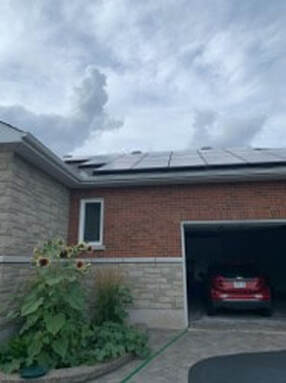
6. Monitor and Evaluate Outcomes
When you have completed your carbon reduction projects, keep track of your energy bills so you can see the financial benefits of your actions and determine your new, substantially downsized, carbon footprint. This will also enable you to verify your vendors’ promised performance claims.
Once the work is done and any incentive checks have been received, it's time to enjoy a cleaner, healthier, and more environmentally responsible lifestyle.
To further enhance your contribution toward carbon reduction, consider letting your home serve as an example to your neighbors and others in your community. You may wish to provide tours and mentor others with the knowledge you’ve gained.
When you have completed your carbon reduction projects, keep track of your energy bills so you can see the financial benefits of your actions and determine your new, substantially downsized, carbon footprint. This will also enable you to verify your vendors’ promised performance claims.
Once the work is done and any incentive checks have been received, it's time to enjoy a cleaner, healthier, and more environmentally responsible lifestyle.
To further enhance your contribution toward carbon reduction, consider letting your home serve as an example to your neighbors and others in your community. You may wish to provide tours and mentor others with the knowledge you’ve gained.
1. This is the general sequence - depending on your location, applying for incentives may come at a different point in the process.
2. Maguire et al., Comparison of Advanced Residential Water Heating Technologies in the United States, NREL https://www.nrel.gov/docs/fy13osti/55475.pdf p.6.
2. Maguire et al., Comparison of Advanced Residential Water Heating Technologies in the United States, NREL https://www.nrel.gov/docs/fy13osti/55475.pdf p.6.
